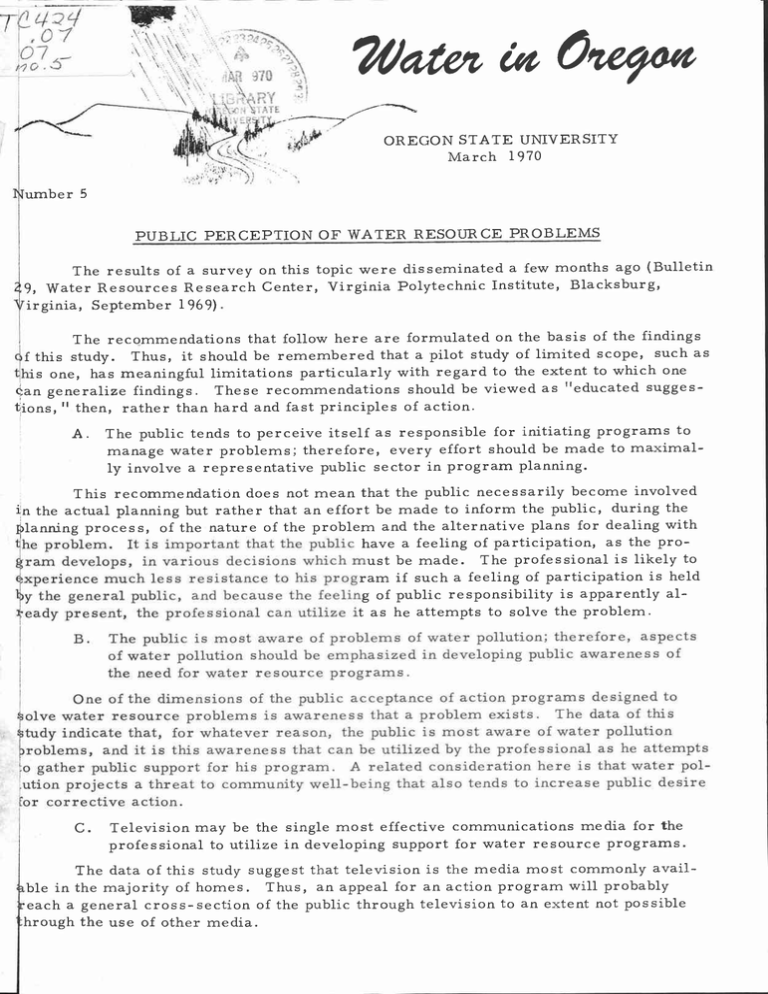?Oae ãt vol 07_ Ta
advertisement

Ta vol ?Oae ãt 07_ -3 7 OREGON STATE UNIVERSITY March 1970 umber 5 PUBLIC PERCEPTION OF WATER RESOURCE PROBLEMS The results of a survey on this topic were disseminated a few months ago (Bulletin 9, Water Resources Research Center, Virginia Polytechnic Institute, Blacksburg, irginia, September 1969) The recommendations that follow here are formulated on the basis of the findings f this study. Thus, it should be remembered that a pilot study of limited scope, such as is one, has meaningful limitations particularly with regard to the extent to which one an generalize findings. These recommendations should be viewed as "educated suggestions," then, rather than hard and fast principles of action. A. The public tends to perceive itself as responsible for initiating programs to manage water problems; therefore, every effort should be made to maximally involve a representative public sector in program planning. This recommendation does not mean that the public necessarily become involved 1n the actual planning but rather that an effort be made to inform the public, during the 1lanning process, of the nature of the problem and the alternative plans for dealing with the problem. It is important that the public have a feeling of participation, as the proram develops, in various decisions which m ust be made. The professional is likely to ¶xperience much less resistance to his prog ram if such a feeling of participation is held y the general public, and because the feelin g of public responsibility is apparently albeady present, the professional can utilize i t as he attempts to solve the problem. B. The public is most aware of problems of water pollution; therefore, aspects of water pollution should be emphasized in developing public awareness of the need for water resource programs. One of the dimensions of the public acceptance of action programs designed to olve water resource problems is awareness that a problem exists. The data of this tudy indicate that, for whatever reason, the public is most aware of water pollution roblems, and it is this awareness that can be utilized by the professional as he attempts M gather public support for his program. A related consideration here is that water p01ution projects a threat to community well-being that also tends to increase public desire [or corrective action. C. Television may be the single most effective communications media for the professional to utilize in developing support for water resource programs The data of this study suggest that television is the media most commonly availble in the majority of homes. Thus, an appeal for an action program will probably each a general cross-section of the public through television to an extent not possible hrough the use of other media. In general, the middle and upper class are the most aware of water resource problems and of the need for corrective action. Educational efforts, therefore, should be directed primarily toward the lower middle and lower classes. This general recommendation does not mean that support can be assumed from the middle and upper classes but only that in a program which demands broad based public endorsement, special efforts should be made to develop support among the lower middle and lower class public. In general, such efforts should attempt to demonstrate a Tpay_offU for the "average" man who, the data of this study suggests, is aware of various interest groups and the role they play in water resource problems. D. STUDENTS ARE PROTESTING In Oregon, and across the nation, students are organizing to protest --- protest against further pollution of our environment. This active involvement in current efforts to produce a better quality of life will climax with a national teach-in on April 22. The participants want to do more than just talk about the problem. Among their objectives are the following: 1. Establish lower division courses in human ecology; 2. Promote formation of an interdisciplinary School of Human Environment as recommended in a report issued by the White House in November 1969; 3. Stimulate broad-based interdisciplinary approach to research; Emphasize dangers of one-problem-one-solution approach, Encourage interdisciplinary activities to divert increasing specialization and departmental isolation into a holistic approach to environmental studie, 4. Become a political lobbying force for environmental issues; 5. Confront present industrial institutions and municipalities with environmental issues and responsibilities toward future growth and development. If you have a son or daughter in or out of college, tell him (her) to join this "militant" group on any campus. The students have labeled their program Eco-Alliance and need a lot of help and encouragement at all levels, from all ages. FLOOD PLAIN MANAGEMENT FOR OREGON CITIES AND COUNTIES is the title of a booklet published in August 1969 by the Bureau of Governmental Research and Service at the University of Oregon. It is designed to provide cities and counties with background information regarding opportunities available to local governments. It includes information on the regulations in effect in Oregon and data on the federal flood insurance program The largest desalting plant operating today in the free world is in Baja California, Mexico, and produces 7 1/2 million gallons daily of fresh water. NEW DIRECTOR FOR THE INSTITUTE Dr. Peter C. Klingeman, As sociate Profes sor of civil engineering, has been named as Acting Director of the Water Resources Research Institute at Oregon State University. He replaces Dr. Emergy N. Castle, head of the Department of Agricultural Economics, who has held the position for the past three years. In making the announcement, Dean George W. Glee son, School of Engineering, who is chairman of the Executive Committee of the Institute, indicated that the current search for a Director will continue. He asked that all communications to the Institute be directed to William H. Buckley, Executive Secretary, 115 Covell Hall. Dr. Klingeman's responsibilities as Acting Director will be in addition to his teaching and research activities in his Department. He received his Ph.D. in civil engineering from the University of California at Berkeley and has been at OSU since 1966. His fields of interest include applied hydrology and water resource development, river hydraulics and sediment problems in rivers and estuaries. Active in organizing the Institute in 1960, and associated with it in various roles ever since, Dr. Castle asked to be relieved of the Institute's management because of the pressure of other duties. One of his principal assignments is that of functioning as a member of the three-man Commission appointed to make recommendations regarding future goals of the university. He is still a member of the State Water Resources Board. RECENT FEDERAL GRANTS The FWPCA has granted funds to a number of Oregon communities for construction or improvement of waste treatment facilities. Under the clean Water Restoration Act of 1966, FWPCA can pay from 30% to 55% of the estimated cost. Grants went to White City - $5, 580; Dundee -$79, 740; North Roseburg - $21, 830; Gresham - $222, 750,; Troutdale - $33, 120; Veneta - $66, 540; Maim - $36, 200 (additional financing); Bandon $134, 250; Moro - $23, 100; North Powder - $25, 500. It has been announced that regulations will be revised so that municipalities and other agencies will have to provide secondary treatment of sewage in order to qualify for assistance. Up until now, grants could be obtained for the building of plants capable of providing only primary treatment which can remove only between 30% and 50% of pollutants. Secondary treatment removes 85% or more of impurities in waste water. A $42, 000 federal water and sewage facilities grant for Wood Village from the U. S. Department of Housing and Urban Development has been approved. The money is aimed primarily at a solution to a critical water supply problem in the east Multnomah County city. 3a0 'si[EAJoD OO °N W-'.'d UJYd ESOd S fl a0 JoJJ_uoN TL6 UOJQ 'SiIIeAtoD TI ITH TIAOD LflhIISNI HD VSaI SDTf1OSI T]LV kts.IAiufl UOI CANAL LININGS Plastic film is one of the many materials developedby the Bureau of Reclamation (BLM) for lining canals. Their Research Report No. 19, 1969, discusses more than 20 years of field and laboratory investigations and experience with buried plastic film used to supress seepage in canals and other waterways. In brief, testing and field performance evaluations of polyvinyl - chloride (PVC) and polyethylene plastic films indicate that these materials can be used satisfactorily as buried membrane linings. Both materials must be compounded by the manufacturer specifically for canal lining purposes to ensure longtime service. Neither material is suitable as exposed lining and must be protected by a minimum of 1 foot of earth cover. laboratory analysis of PVC lining after seven years' service and polyethylene lining after four years' service indicates no change in these materials. PVC and polyethylene plastic membrane linings in use for 10 years are giving excellent service. These linings are low cost and easy to install, requiring a minimum of equipment and skilled labor. Short-term laboratory tests on newer ethylene vinyl acetate copolymer and chlorinated polyethylene plastic films indicate that these materials have possibilities as canal linings. Continued testing of these plastics is necessary to ascertain possible advantages over the PVC and polyethylene linings, according to the BLM report, available at the U.S. Government Printing Office.




